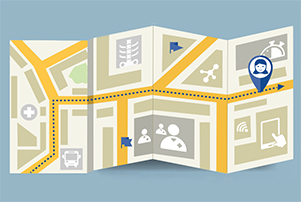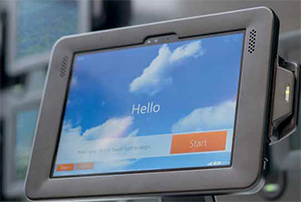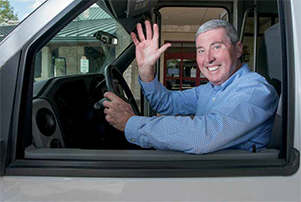 The Patient Experience
The Patient Experience
At Baylor Scott & White Health, our patients are at the heart of everything we do. Every decision, every action, and every investment we make is because we strive to do what’s best for them when it comes to their healthcare. We’re increasing our efforts to optimize the patient experience, which means going beyond delivering the best clinical care to meet patients’ other needs, which range from improvements in our support programs and physical environments, to better communications and educational efforts.
Here, great care means more than medical excellence alone. Technology, expertise, and experience enable us to do so much for so many. In an effort to elevate each patient’s experience, we’re implementing an array of programs that go beyond the clinical realm to help patients navigate our healthcare system more easily and interact with us on their own terms.
These efforts include listening to patients’ feedback through comments and tweets posted on sites such as Facebook and Twitter so we can respond in the most effective ways. Nikki Moll, Baylor Scott & White Health vice president of public relations says, “Social media is the new coffee shop. People turn to it to learn their friends’ opinions and hear about their experiences. Baylor Scott & White Health is proud to be on the front end of this new opportunity to serve patients. We have the ability to solve problems in real time and can implement operational changes when we see patterns. It’s just one more way to connect with those we serve.”
Baylor Scott & White Health has a new social media listening center that was modeled after similar centers at Dell Computers and Southwest Airlines, both companies known for excellence in service. We’re developing and implementing programs to improve the patient experience across the healthcare system in so many ways, and there’s more to come. Here are a few ways we’re working to serve you better:
Technology engages patients in Austin
 With almost a million residents, Austin is one of the country’s fastest-growing cities and is a magnet for young, technology-focused careerists as well as retirees attracted to the climate and culture. We opened the first Baylor Scott & White Health clinic in downtown Austin in January, with a goal to provide healthcare in a way that appeals to young and old—and everyone in between. So far, our efforts are paying off, with patients offering positive feedback.
With almost a million residents, Austin is one of the country’s fastest-growing cities and is a magnet for young, technology-focused careerists as well as retirees attracted to the climate and culture. We opened the first Baylor Scott & White Health clinic in downtown Austin in January, with a goal to provide healthcare in a way that appeals to young and old—and everyone in between. So far, our efforts are paying off, with patients offering positive feedback.
“By entering the Austin market for the first time, we wanted to offer a healthcare experience as engaging, exciting, and high-tech as Austin itself,” says Chris Kriczky, clinic operations director for the Austin/Round Rock region. “We wanted to make excellent care easy to access for people of all ages.”
An intensive and creative clinic planning process included thinking “out of the box”—group brainstorms; random interviews with Austinites on streets, in parks, and in cafes; and finally, formal focus groups to test and refine ideas. This resulted in a new clinic like no other.
The lobby features an art wall of 15 tablets displaying such Austin icons as Lady Bird Lake, legendary wall graffiti from a South Congress (“SoCo”) coffee shop, and the capitol dome. Attention to other details gives patients a greater sense of control over their healthcare because it gives them more options. For example, patients have a choice when it comes to checking in for appointments: they can check in the traditional way, by seeing a receptionist when arriving at the clinic, or they can check in online in advance. In the exam room, a 42-inch touch screen monitor displays a patient’s health information, such as lab results. This information comes from the patient’s electronic health record, which puts all the patient’s pertinent information in physicians’ hands with the touch of a button. Care at the clinic includes a family medicine provider and advanced practice professionals who offer both traditional an integrative medicine, such as acupuncture and therapeutic massage. An orthopedic surgeon also sees patients at the clinic weekly.
Virtual visits and house calls
“The Austin clinic offers so many innovative ways to receive care,” says Jacob Scott, project manager at the Baylor Scott & White Health digital health office in Dallas. Some options eliminate the need for an office visit altogether. E-visits connect patients with a physician assistant or nurse practitioner for prescription refills or help with colds, flu, sinus infections, sore throats, and other common ailments. Video visits allow people with chronic conditions, such as diabetes, asthma, or heart disease, to “see” their specialists in Round Rock, Temple, or Dallas from their home, office, or just about anywhere with a secure internet access and a web camera. A nurse practitioner will even make a house call for patients within 10 miles of downtown on weekdays from 8 a.m. to 5 p.m.*
“It’s about choice, quality, and convenience,” says Mr. Kriczky. “We’re creating the kind of healthcare experience in Austin that people, literally, dreamed of.”
College Station morning huddle
 Every morning, almost 40 Baylor Scott & White College Station leaders gather in a conference room and, for 15 minutes, discuss just one thing. “We ask a simple question: Is there anyone, any patient, in the hospital today who would not rate our hospital a 9 or 10?” says Jason Jennings, president of the College Station region for Baylor Scott & White. “And we’ve been asking that every day since our hospital opened in August 2013. This is a collegial and collaborative effort to identify problems and solve them immediately.” Issues discussed range from delayed lunch delivery to patients’ rooms or long waiting times for appointments. Every problem is addressed with a commitment to improvement.
Every morning, almost 40 Baylor Scott & White College Station leaders gather in a conference room and, for 15 minutes, discuss just one thing. “We ask a simple question: Is there anyone, any patient, in the hospital today who would not rate our hospital a 9 or 10?” says Jason Jennings, president of the College Station region for Baylor Scott & White. “And we’ve been asking that every day since our hospital opened in August 2013. This is a collegial and collaborative effort to identify problems and solve them immediately.” Issues discussed range from delayed lunch delivery to patients’ rooms or long waiting times for appointments. Every problem is addressed with a commitment to improvement.
Employees make all the difference in delivering a great patient experience, and they’re given the tools to be more successful. “We hire people who are good at what they do and understand service,” says Mr. Jennings. Mr. Jennings also often dons scrubs and shadows the nurses to see firsthand how things are going. “I like to see how our patients—and employees—are doing,” he says. “We do every small thing possible so people have a good experience in our hospital. Do little things over and over and it becomes the fabric and foundation of care, and a culture of service.”
Cancer navigators in Temple
In 2016, more than 2,000 people received a cancer diagnosis at the Vasicek Cancer Treatment Center on the campus of Scott & White Medical Center - Temple. “It’s often very upsetting for patients who have just been diagnosed,” says Theresa Kelly, RN, and center director. “They are wondering, ‘What does this mean for my family and me? Am I going to die?’ They’re overwhelmed at a time when there’s a lot of information to take in, and they need support.” To help, in 2012 the cancer center hired its first breast cancer nurse navigator, a registered nurse who helps support patients through the toughest fight of their lives. The program was so successful that the center has added two more nurse navigators to work with lung and gastrointestinal cancer patients. “Nurse navigators transform a patient’s experience by providing that extra human touch,” Ms. Kelly says.
“After hearing the word cancer, patients are often overwhelmed, and at times they don’t fully grasp all the information they need,” says Jennifer Havens, a lung cancer nurse navigator. “It’s my job to help them understand everything and to reinforce the education that the physician provided. I help answer additional questions they may have and act as a patient advocate.”
Nurse navigators support patients through any combination of surgery, chemotherapy, and radiation. They help coordinate appointments and make connections—to social workers, reliable web sites for information, peer support programs, transportation, and prescription and financial assistance.
Nurse navigators also continue working with patients after treatment is complete. Together, they establish a five-year survivorship care plan for the patient, which includes recommended exams such as imaging, lab work, and visits with a provider. Navigators also help patients address any lingering side effects and how to manage them, and provide resources that focus on nutrition, exercise, insurance, and other survivorship topics.
“There’s a lot of follow up after patients are in remission, and we continue to be here for them,” says Ms. Havens.
Hillcrest Patient and Family Advisory Council in Waco
Every day, Holly Ivy, a former emergency room nurse and stroke coordinator, makes rounds at Baylor Scott & White Medical Center - Hillcrest in Waco, spending at least five to ten minutes in as many patient rooms as she can. “I hear great suggestions from patients,” she says, and in her current role as patient experience liaison at Hillcrest, she can implement them.
Ms. Ivy organized the Patient and Family Advisory Council to tap into the wisdom of former patients, family members, and community leaders. The council of ten volunteers meets monthly to come up with ways to improve the patient experience. Their first project is a “concierge” folder for newly admitted patients. “As our volunteers shared their own experiences at Hillcrest, they expressed feeling confused early on,” she says. “The folder covers basics like how to access wireless service, and gives gift shop and café hours. It also explains the role of hospitalists and how to organize medications, contacts, and special instructions. It was much-needed.”
The council also inspired staffers to sit in room recliners and lay in beds, as patients do. From that perspective, it was clear some rooms needed modernizing. “Sometimes we’re so busy and task-focused we forget the little things,” says Ms. Ivy. “Our medical expertise is excellent, but the personal touch is just as important.”
A shuttle driver delights in Round Rock
 Jerry Crabtree, of Round Rock, found his calling behind the wheel of a Baylor Scott & White van. Retired from a long and successful career in sales, Mr. Crabtree was looking for a job with purpose, something to keep him busy in retirement, when a want ad caught his eye: A driver was needed for the shuttle between a retirement community in Georgetown and the various Baylor Scott & White clinics in Round Rock.
Jerry Crabtree, of Round Rock, found his calling behind the wheel of a Baylor Scott & White van. Retired from a long and successful career in sales, Mr. Crabtree was looking for a job with purpose, something to keep him busy in retirement, when a want ad caught his eye: A driver was needed for the shuttle between a retirement community in Georgetown and the various Baylor Scott & White clinics in Round Rock.
Today, Mr. Crabtree makes the round trip five times a day from Sun City to Round Rock clinics up to 30 miles away. As he says, he’s found his ministry—and his riders are thrilled. In wheelchairs, on electric scooters, and with canes and walkers, they make their way to the van to catch a ride or just say hello.
Mr. Crabtree says, “They tell me every day how much they appreciate this shuttle. Rain or shine, we’re here for them.” Driving 50 seniors a week to and from appointments has showered him with enduring friendships, great stories, and lots of homemade tamales. “Many of my riders are very sick and going through a lot of anxiety. If I can give a word of encouragement, a smile, or hug, that makes my day,” he says.
"Jerry is so outgoing and nice,” says one rider, setting a container of homemade cookies on his seat. “He just puts me at ease.”
Mr. Crabtree says, “These people have experienced every physical ailment imaginable, from losing their eyesight to cancer, yet they still come on here smiling. They’ve taught me a great deal about perseverance. I’m sure this bus builds patient satisfaction, but for me, it’s just the greatest job in the world.”
Baylor Scott & White McLane Children’s: Education is key
 Class is in session when David Dixon is perched on a bedside, giving lessons to patients at Baylor Scott & White McLane Children’s Medical Center, just as they would receive in the classroom back at their school. The former teacher and retired principal is researching Queen Victoria with his student, a high school freshman and patient at McLane Children’s.
Class is in session when David Dixon is perched on a bedside, giving lessons to patients at Baylor Scott & White McLane Children’s Medical Center, just as they would receive in the classroom back at their school. The former teacher and retired principal is researching Queen Victoria with his student, a high school freshman and patient at McLane Children’s.
“I’ve been emailing her teacher and getting homework assignments so she can keep up with her algebra, chemistry, English, and history. The challenge is to provide relevant lessons on a very fast time line,” he says.
Mr. Dixon is hired by the local school district to work at McLane Children’s, designated a school for children who need to stay overnight or longer so that a hospital stay does not count as a school absence. By tutoring and communicating with the school, Mr. Dixon’s role is to ensure that students’ time is well spent. “Education is a huge part of a child’s development, and we want to keep life as normal as possible,” says Mr. Dixon. “The number one priority is to get children well, but secondly, we want to help them keep up in school as well as they can. It’s one less thing for a family to worry about.”
Mr. Dixon visits every single room at Baylor Scott & White McLane Children’s Medical Center daily, giving special attention to children facing more than three days in the hospital. “The children are surprised to see me at first, thinking, ‘Wow, I’m in a hospital and a teacher shows up?’” he says. “The parents are more pleased. If they want me to work with their child, I will.” Mr. D, as he’s known, tries to get in four lessons during a week, considered full-time attendance for children ages four to 19.
Carolyn Jackson, director of the Emergency Department and inpatient medical and surgical unit at McLane Children’s, says, “No one wants to come to a hospital. But when quality patient care and an excellent patient experience are combined, it’s a real win-win for children.”
The patient experience at Baylor Scott & White Health is one that encompasses many aspects of health management. We’re integrating technology to make your encounters with us more convenient, with innovative programs and a compassionate touch to ease patients’ burdens. We want your interactions with us to be the best they can possibly be, while setting new standards in healthcare delivery throughout our system.
Read more in this issue